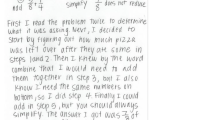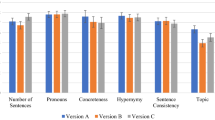Abstract
This paper reports on two inter-related studies that examined the use of non-traditional writing strategies within secondary school science classrooms. The first study involved Year 10 students who incorporated one letter writing experience into the learning sequence when studying genetics. The second study was with Year 9 students who used both a non-traditional laboratory writing heuristic and letter writing as part of the learning sequence when studying a topic on light. The same teacher was involved in both case studies. A higher-level analogy question was added to the teacher-prepared tests for each study to examine if students who participated in writing-to-learn activities were able to perform significantly better as a group than a group of students who completed traditional teacher directed laboratory activities and note-taking. Results indicate that for the first study there was not a significant difference using t-test analysis, while for the second study involving two writing treatments there was a statistically significant difference using t-test analysis. There was no statistically significant difference in responses between treatment and control groups when answering low level recall questions for either case study. Student interviews indicated awareness by students of the metacognitive value gained by using the non-traditional writing types.
Similar content being viewed by others
References
Baker, D. R. & Piburn, M. D. (1997). Constructing science in middle and secondary school classrooms. Boston: Allyn & Bacon.
Barden, L. M. (1995). Effective questioning and the ever-elusive higher order question. The American Biology Teacher, 57(7), 423-426.
Barnes, D. (1976). From communication to curriculum. Harmondsworth, UK: Penguin.
Barnes, D. (Ed.). (1986). Language in the secondary classroom. Harmondsworth, UK: Penguin.
Bereiter, C. & Scardamalia, M. (1987). The psychology of written composition. Hillsdale, NJ: Erlbaum.
Bruner, J. S. (1964). Course of cognitive growth. American Psychologist, 19(1), 14.
Crooks, T. J. (1988). The impact of classroom evaluation practices on students. Review of Educational Research, 58(4), 438-481.
Duffy, T. M. & Cunningham, D. J. (1996). Constructivism: Implication for the design and delivery of instruction. In D. H. Jonassen (Ed.), Handbook of research for educational communications and technology (pp. 170-198). London: Prentice-Hall International.
Emig, J. (1977). Writing as a mode of learning. College Composition and Communication, 28(May), 122-128.
Fitzpatrick, K. (1994). Improving reading comprehension using critical thinking strategies. Reading Improvement, 31(3), 142-144.
Hand, B., Prain, V., & Scholes, I. (1996). Light learning. The Science Teacher, 63(9), 38-40.
Hand, B., Prain, V., Lawrence, C., & Yore, L. (1999). A writing in science framework designed to improve science literacy. International Journal of Science Education, 21, 1021-1035.
Hand, B. & Keys, C. W. (1999). Inquiry investigation. The Science Teacher, 66(4), 27-29.
Holliday, W. G., Yore, L. D., & Alvermann, D. E. (1994). The reading-science learning-writing connection: Breakthroughs, barriers and promises. Journal of Research in Science Teaching, 31(9), 877-893.
Keys, C. W. (1999). Revitalizing instruction in scientific genres: Connecting knowledge production with writing-to-learn science. Science Education, 83, 115-130.
Keys, C. W., Hand, B., Prain, V., & Collins, S. (1999). Using the science writing heuristic as a tool for learning from laboratory investigations in secondary science. Journal of Research in Science Teaching, 36, 1065-1084.
Martin, R., Sexton, C., Wagner, K., & Gerlovich, J. (1998). Science for all children. Methods for constructing understanding. Boston: Allyn & Bacon.
Prain, V. & Hand, B. (1996). Writing for learning in secondary science: Rethinking practices. Teaching and Teacher Education, 12(6), 609-626.
Prain, V. & Hand, B. (1999). Students perceptions of writing for learning in secondary school science. Science Education, 83, 151-162.
Rivard, L. (1994). A review of writing-to-learn in science: Implications for practice and research. Journal of Research in Science Teaching, 31(9), 969-983.
Author information
Authors and Affiliations
Rights and permissions
About this article
Cite this article
Hand, B., Prain, V. & Wallace, C. Influences of Writing Tasks on Students' Answers to Recall and Higher-Level Test Questions. Research in Science Education 32, 19–34 (2002). https://doi.org/10.1023/A:1015098605498
Issue Date:
DOI: https://doi.org/10.1023/A:1015098605498




